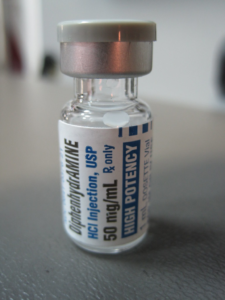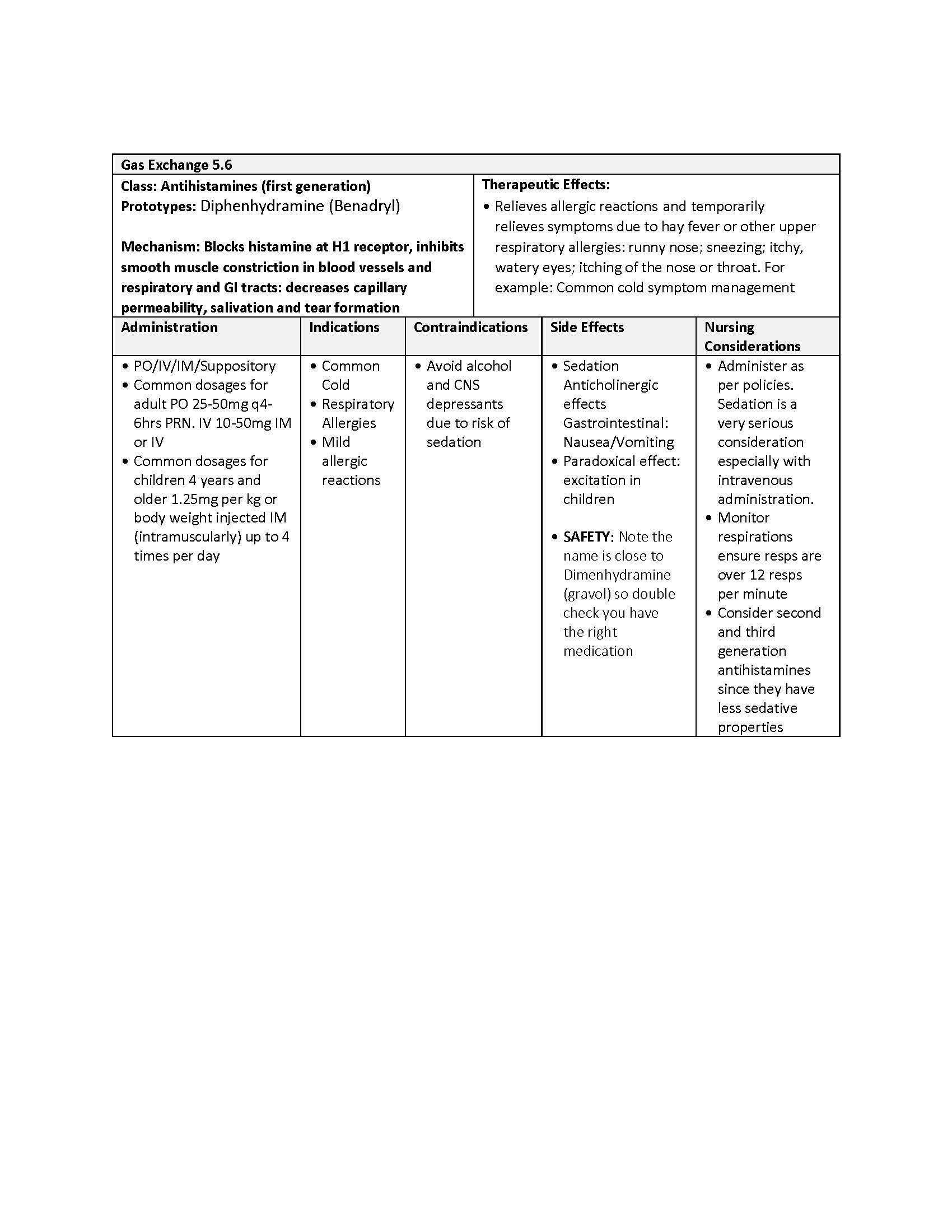Gas Exchange
5.6 Antihistamines
Open Resources for Nursing (Open RN)
Antihistamines
Diphenhydramine and Cetirizine are two commonly-seen antihistamine drugs. In this chapter we explore Diphenhydramine.
Diphenhydramine is an example of a first-generation antihistamine. (See Figures 5.6[1] and 5.6a.[2]) Second-generation antihistamines were developed to have fewer side effects. An example of a second-generation antihistamine is cetirizine.


Mechanism of Action
Antihistamines have the following mechanisms of action: blocks histamine at H1 receptors; inhibits smooth muscle constriction in blood vessels and the respiratory and GI tracts; and decreases capillary permeability, salivation, and tear formation.
Indications for Use
Antihistamines are used for relief of allergy or cold symptoms.
Nursing Considerations Across the Lifespan
This medication is not safe for children under the age of 2 years without a healthcare provider’s order.
Adverse/Side Effects
First-generation medications can cause anticholinergic effects (such as dry mouth, urinary retention, constipation and blurred vision). CNS depression or CNS stimulation with excessive doses can occur, especially in children. Therefore, first-generation antihistamines should be used with caution in the elderly.
Second-generation medications may cause headache, nausea, vomiting, dysmenorrhea, and fatigue.[3]
Client Teaching & Education
Clients should be advised that antihistamines may cause drowsiness, and concurrent use of alcohol or other CNS depressants should be avoided. Clients should take only the recommended amount of medication and not exceed dosing recommendations. Some clients may experience side effects such as dry mouth, and frequent oral hygiene may assist in alleviating discomfort.[4]
Now let’s take a closer look at the medication grid for diphenhydramine and cetirizine in Table 5.6.[5], [6], [7] Medication cards are intended to assist students to learn key points about each medication class. Basic information related to a common generic medication in this class is outlined, including administration considerations, therapeutic effects, and side effects/adverse effects. Prototype/generic medication listed in the medication card is also hyperlinked to a free resource from Daily Med. Because information about medication is constantly changing, nurses should always consult evidence-based resources to review current recommendations before administering specific medication.
Table 5.6 Diphenhydramine Medication Card [8]

Media Attributions
- image11-5
- image10-4
- Gas Exchange 5
- "Benadryl Allergy USA" by ZenBenjamin is licensed under CC BY-NC-SA 2.0 ↵
- "diphenhydramine (1)" by Intropin is licensed under CC BY-NC 2.0 ↵
- Frandsen, G. & Pennington, S. (2018). Abrams’ clinical drug: Rationales for nursing practice (11th ed.). Wolters Kluwer. ↵
- uCentral from Unbound Medicine. https://www.unboundmedicine.com/ucentral ↵
- This work is a derivative of Pharmacology Notes: Nursing Implications for Clinical Practice by Gloria Velarde licensed under CC BY-NC-SA 4.0. ↵
- Frandsen, G. & Pennington, S. (2018). Abrams’ clinical drug: Rationales for nursing practice (11th ed.). Wolters Kluwer. ↵
- This work is a derivative of Daily Med by U.S. National Library of Medicine in the public domain. ↵
- This work is a derivative of Daily Med by U.S. National Library of Medicine in the public domain. ↵

